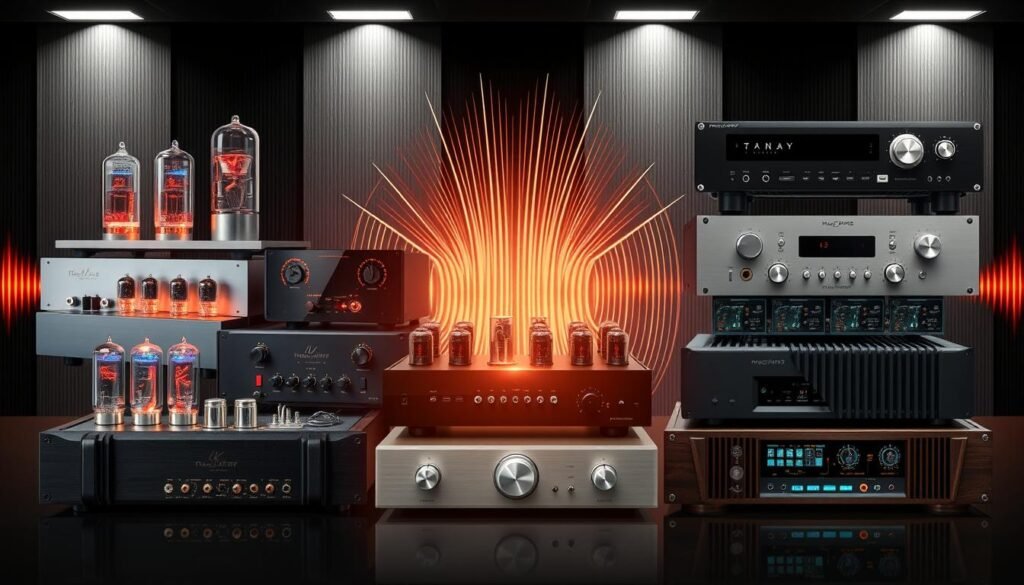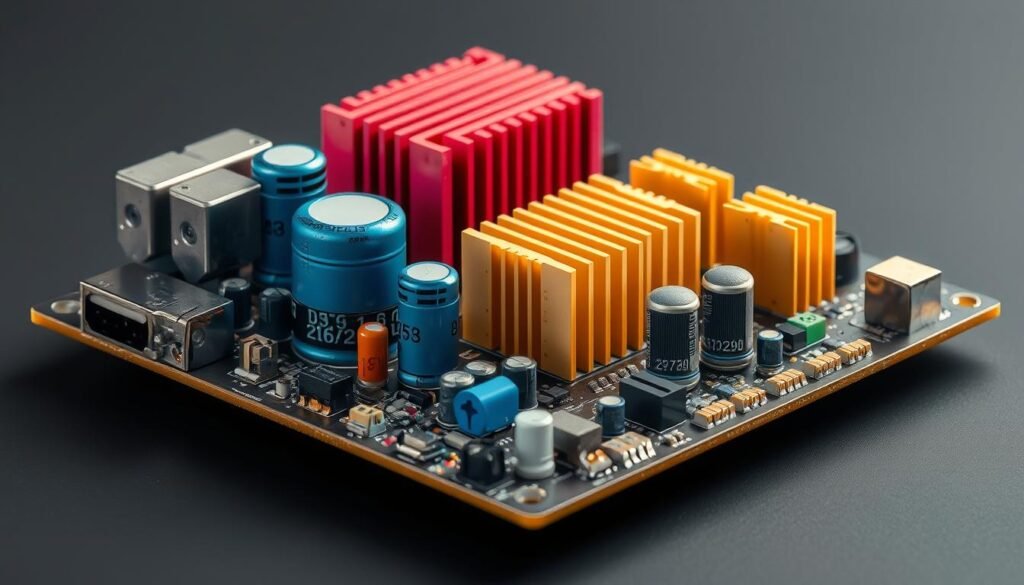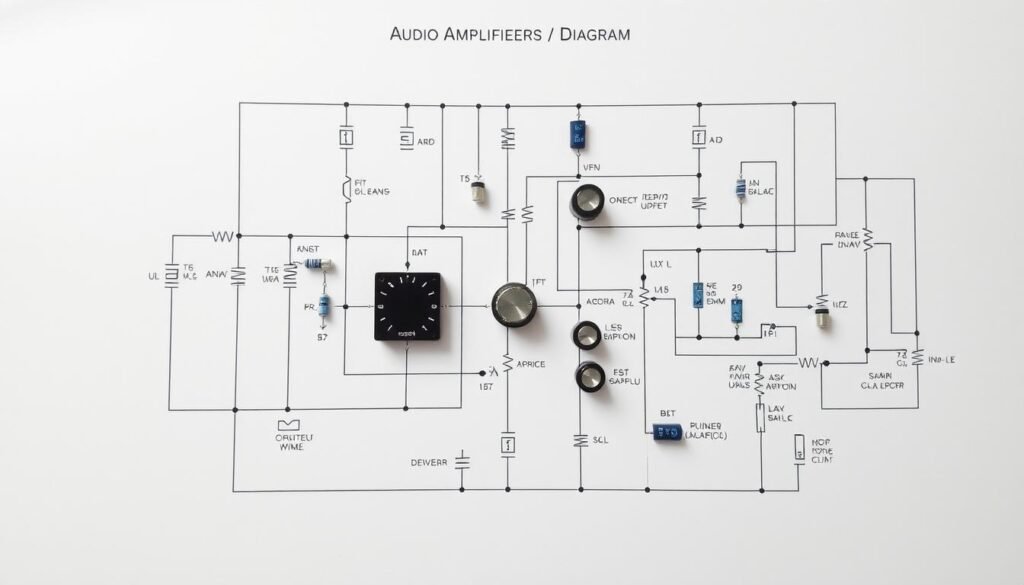מגברי קול מחזקים את האותות ממקור השמע שלך כדי להפעיל רמקולים. הם חיוניים לכל מערכת קול. לדעת את היסודות עוזר לך לבחור בחוכמה את ההגדרה שלך.
סוגים שונים של מגברים מציעים יתרונות ייחודיים. מגברים סולידיים הם אמינים וזולים. מגברי שפופית מספקים צליל חם ועשיר.
מגברים היברידיים משלבים דיוק סולידי עם תכונת שפופית. מגברים משולבים משלבים פריאמפ ומגבר כוח ביחידה אחת. מגברי כוח מתמקדים רק ב-הגברת האות.
כאשר בוחרים מגבר, חשוב לשקול את הפלט והיעילות. יש לבדוק תאימות עם הרמקולים שלך ועם רכיבים אחרים. חשוב גם לשמור על התקציב שלך.
המגבר הנכון יכול לשפר מאוד את חוויית ההאזנה שלך. זה מרכזי ליצירת מערכת קול באיכות גבוהה. בחר בחוכמה כדי ליהנות מצליל טוב יותר לשנים.
מסקנות מרכזיות
- מגברי קול הם רכיבים חיוניים שמגבירים את הכוח של אות שמע כדי להניע רמקולים ביעילות.
- סוגי מגברים שונים, כגון סוליד-סטייט, למנורות, היברידי, משולב ומגברי כח, מציעים יתרונות ותכונות ייחודיים.
- כאשר בוחרים מגבר, חשבו על יצוא הכוח, יעילות, תאימות עם רמקולים ורכיבים אחרים, והגבלות בתקציב.
- הבנת יסודות מגבר שמע עשויה לעזור לכם לקבל החלטות מושכלות בבניית או שדרוג המערכת שמע שלכם.
- המגבר הנכון עשוי לשפר באופן משמעותי את חוויית ההאזנה שלכם ואת איכות הצליל הכוללת.
מבוא למגברי שמע
מגברי שמע הם חלקים מרכזיים במערכות שמע. הם מחזקים את האותות השמע להאזנה באיכות גבוהה. הבנת כיצד הם עובדים עוזרת להשיג את הצליל הטוב ביותר.
מהו מגבר שמע?
מגבר שמע מחזק את האותות השמע החלשים. הוא מחזק אותם למידה מספיקה כדי להפעיל רמקולים. המכשיר הזה מקבל אותות מנגנים או טלפונים ומחזק אותם.
מגברים מגבירים את עוצמת האות בלי לפגוע באיכות הצליל. הם משתמשים בטרנזיסטורים או בצינורות ריקים לתהליך זה. המטרה היא לשמור על איכות הצליל המקורית.
תפקידם של המגברים במערכות השמע
המגברים מחברים מקורות שמע לרמקולים. הם מבטיחים שהאותות חזקים מספיק לצליל ברור. בלעדיהם, השמע היה חלש או משונה.
המגברים מקבלים אותות ברמה נמוכה ממקורות שמע. הם מחזקים את האותות הללו כדי להתאים אותם לצרכי הרמקול. התהליך הזה חיוני לאיכות צליל טובה.
קיימים סוגים שונים של מגברים. אלה כוללים עיצובים סולידיים, צינורות ריקים והיברידיים. הבחירה תלויה בהעדפות הצליל ובצרכי המערכת.
בקיצור, המגברים חיוניים לצליל מעולה. הם מחזקים את האותות כדי שהרמקולים יוכלו להשתמש בהם. הבנת המגברים עוזרת ליצירת חוויות שמע טובות יותר.
סוגי מגברי שמע
מגברי שמע מגיעים בסוגים שונים, כל אחד עם תכונות ייחודיות ויתרונות. הקטגוריות העיקריות כוללות מגברים סולידיים, צינורות ריקים ומגברים היברידיים. קיימת גם הבדל בין מגברים משולבים למגברי כוח.
להבנת ההבדלים הללו עוזר לך לבחור את המגבר הנכון עבור מערכת השמע שלך. כל סוג מציע איכויות סאונד שונות ותכונות ביצוע מזהים.
מגברים מצב קואי
מגברים מצב קואי משתמשים בחומרי חצובה כדי להגביר את האותות השמע. הם מכונים על אמינות, תחזוקה נמוכה, ושחזור סאונד נקי. מגברים אלו מציעים טווח דינמי רחב ותגובת transient מעולה.
מגברי מצב קואי מתאימים לגרסאות שונות של מוזיקה ולהעדפות האזנה שונות. הם הפכו להיות הסוג הכי נפוץ במערכות השמע המודרניות.
מגברי לוחות צינורות
מגברי לוחות צינורות יש להם היסטוריה עשירה בתחום השמע. הם משתמשים בלוחות צינורות כדי להגביר את האותות, יוצרים סאונד חם ועשיר. רבים מהאודיופילים מעריכים את הטווח האמצעי החלק והגבוה המפורט שלהם.
מגברי לוחות צינורות מספקים עומק וממדיות לסאונד. אך, הם דורשים יותר תחזוקה ויוצרים יותר חום מאשר מגברים מצב קואי.

מגברים היברידיים
מגברים היברידיים משלבים טכנולוגיות של סוליד-סטייט ושל שנתות ריקון. כללית הם משתמשים בשנתות בשלב הפריאמפ עבור תכונות סאונד מבוקשות. שלב הכוח משתמש במעגלי סוליד-סטייט ליעילות ואמינות.
מטרתם של מגברים אלו היא לספק חוויית האזנה מאוזנת. הם משלבים חום של שנתות עם דיוק ושליטה של סוליד-סטייט.
מגברים משולבים נגד מגברי כוח
מגברים משולבים משלבים שלבי פריאמפ ומגבר כוח ביחידה אחת. הם עוסקים בבחירת קלט, בשליטת עוצמת הקול ובהגברה. עיצוב זה מציע פתרון נוח הכולל הכל באחת.
מגברי כוח מתמקדים בהגברת סיגנלים שמטרתם להוביל רמקולים. עליהם להשתמש בפריאמפ נפרד לשליטה בעוצמת הקול ובבחירת הקלט. בחירתך תלויה בצרכי המערכת ובהעדפות האישיות שלך.
| סוג מגבר | מאפיינים עיקריים |
|---|---|
| מגברים סוליד-סטייט | אמין, דורש תחזוקה נמוכה, צליל נקי ומדויק |
| מגברים בצינורות ריקון | צליל חם, עשיר ומוזיקלי, דורש תחזוקה נוספת |
| מגברים היברידיים | משלבים את היתרונות של טכנולוגיית סוליד-סטייט וצינורות |
| מגברים משולבים | פתרון הכולל פריאמפ ושלבי כוח |
| מגברי כוח | מתמקדים באיכות ההגברה בלבד, דורשים פריאמפ נפרד |
רכיבים מרכזיים של מגבר שמע
מגברי שמע הם מכשירים מורכבים עם מספר רכיבים מרכזיים. חלקים אלה עובדים ביחד כדי להגביר את הסיגנל הכניסה ולהפעיל רמקולים. הרכיבים העיקריים כוללים את מקור הכוח, הפריאמפליפייר, שלב הפלט, ו-מהפכי שמע.

ה-מקור הכוח חיוני לפעולת המגבר. הוא מספק מתח וזרם יציב למעגל כולו. רכיב זה מבטיח מסירת כוח נקי ל-הפריאמפליפייר ול-שלב הפלט.
ה-הפריאמפליפייר מעלה את הסיגנלים ברמה נמוכה ממקורות כמו נגני CD או מיקרופונים. הוא מכין את הסיגנל להגברה נוספת על ידי שלב הפלט. רכיב זה כולל בדרך כלל בקרות טון ותכונות כיוון עוצמת השמע.
"הפריאמפליפייר הוא השלב הראשון של ההגברה במערכת שמע, ואיכותו יכולה להשפיע משמעותית על הצליל הכולל." – ג'ון סמית, מהנדס שמע
שלב הפלט הוא השלב האחרון של הגברה. הוא לוקח את האות של הפריאמפליפייר ומחזק אותה כדי להניע רמקולים. שלב זה משתמש בטרנזיסטורים עם כוח גבוה או בצינורות ריקות לצורך הגברת זרם ומתח.
מהפכי שמע מקשרים בין שלבי ההגברה השונים ומספקים בידוד חשמלי. הם עוזרים להפחית רעשים ולוודא העברת אות מיטבית. חלק מהמגברים משתמשים במהפכים פלט כדי להתאים אימפדנסית של צינורים לאימפדנסית של רמקולים.
- ספק כוח: מספק כוח נקי ויציב למעגל ההגברה
- פריאמפליפייר: מגביר את האות הכניסה ברמה נמוכה
- שלב פלט: מניע את הרמקולים בכוח גבוה
- מהפכי שמע: מספקים קישור והתאמת אימפדנסיה בין השלבים
הבנת הרכיבים הללו עוזרת להעריך את מורכבות מגברי השמע. כל רכיב משמש תפקיד חיוני בהשגת צליל באיכות גבוהה.
שימוש קולי. בחירה ואינטגרציה של חלקים אלה קובעים את ביצועי המגבר ותכונות הצליל.
מגברי קול: איך הם עובדים
מגברי קול מחזקים את האותות הקוליים כדי להפעיל רמקולים. הם מרכזיים לכל מערכת קול. לדעת איך הם עובדים עוזר לך לבחור את הנכון.
תהליך ההגברה
מגבר קול מחזק אותות חלשים דרך הגברת אות. הוא משתמש בטרנזיסטורים או בצינורות ריקים כדי לשלוט בזרם חשמלי. הרווח של המגבר קובע את כמות ההגברה.
ערכי רווח גבוהים יוצרים אות פלט חזקה יותר. התהליך כולל מספר שלבים שמגבירים את עוצמת האות.

- שלב הקלט: מקבל את האות החלש ומכין אותו להגברה.
- שלב ההגברת מתח: מגביר את מתח האות תוך שמירה על צורתה המקורית.
- שלב ההגברת כוח: מעלה את זרם האות כדי להניע רמקולים.
- שלב הפלט: מוסר את האות המוגבר לרמקולים או להתקנים אחרים.
גורמים המשפיעים על ביצועי המגבר
כמה גורמים משפיעים על ביצועי המגבר ועל איכות הצליל. אלה כוללים עיוות, תגובת תדר, יחס אות לרעש, ו-גורם דמפינג.
- עיוות: שינויים לא רצויים באות המקורית. רמות עיוות נמוכות יותר מעניקות צליל מדויק יותר.
- תגובת תדר: יכולת המגבר להגביר את האותים בכל התדרים השמעיים באופן שווה.
- יחס אות לרעש: האיזון בין האות הרצוי לרעש הלא רצוי. יחסים גבוהים משמעותם צליל נקי יותר.
- גורם דמפינג: כמה טוב המגבר שולט בתנועת כונן הרמקול. גורמים גבוהים מעניקים בס צמוד יותר.
| גורם | תכונות אידיאליות | השפעה על איכות הצליל |
|---|---|---|
| עיוות | נמוך | שחזור שמע מדויק |
| תגובת תדר | שטוח (20 הרץ – 20 קילוהרץ) | הגברה אחידה בכל התדרים |
| יחס אות לרעש | גבוה | רקע נקי ושקט |
| גורם כיבוי | גבוה | תגובת בס מדודה ומדויקת |
להבנת הגורמים הללו עוזר למעריצי אודיו לקבל החלטות חכמות. זה מאפשר להם לבחור את החלקים הטובים ביותר עבור מערכות הצליל שלהם.
עם הידע הזה, תוכל ליצור את חוויית ההאזנה הטובה ביותר שאפשרית. תוכל לייעל את ההגדרה השמעית שלך בצורה יעילה.
בחירת מגבר אודיו הנכון
בחירת המגבר האודיו המושלם מחייבת חשיבה זהירה. עליך להתאים אותו לרמקולים שלך ולשקול את יכולת הפלטה. התקציב שלך וההגדרה של המערכת גם משחקים תפקיד.
התאמת מגברים לרמקולים
התאמה נכונה של מגברים ורמקולים חיונית. לכל רמקול יש יכולות טיפול בכוח ספציפיות ודירוגי אימפדנס. אי התאמות עשויות לגרום לצליל רע, לעיוות או לנזק לציוד.
בחר מגבר שיכול להניע את הרמקולים שלך בצורה טובה. לא צריך שיחרוג ממגבלות הכוח שלהם או יחסר מצרכיהם.
שיקולי יצוא ויעילות
הספק הייצוא והיעילות של המגבר משפיעים מאוד על ביצועי המערכת השמע שלך. הספק הייצוא, שמתקן בוואטים, מראה כמה טוב המגבר יכול להניע את הרמקולים. ספק יותר מאפשר עוצמות קול גבוהות יותר ושליטה טובה יותר ברמקולים.
לשקול את היכולת והיעילות עבור התוצאות הטובות ביותר. מגבר יעיל מספק צליל נקי בלי לבזבז אנרגיה. זה יפחית חום ועלויות לטווח הארוך.
"בחירת המגבר הנכון היא כמו למצוא שותף ריקוד מושלם עבור הרמקולים שלך. הכל על תאימות, איזון והבאת המיטב מכל אחד." – אוהבי צלילי האודיו
תקציב ותאימות למערכת
חשוב לשקול את התקציב שלך בעת בחירת מגבר אודיו. המחירים נעים בין דגמים כניסה לדגמים גבוהים. חפש מגבר שמציע ערך טוב ועונה על צרכיך.
ודא שהמגבר עובד היטב עם הרכיבים האודיו האחרים שלך. עליו להשתלב בצורה חלקה עם הפריאמפ, המכשירים המקוריים והרמקולים שלך.
| סוג מגבר | פלט כוח טיפי | יעילות | טווח מחירים |
|---|---|---|---|
| סוליד-סטייט | 50-200 וואט לערוץ | גבוהה | $200-$1,000 |
| שפופרת ריקה | 10-100 וואט לערוץ | בינונית | $500-$5,000 |
| היברידי | 50-150 וואט לערוץ | בינונית עד גבוהה | $500-$2,000 |
| משולב | 50-200 וואט לערוץ | גבוהה | $300-$2,000 |
שקול בקפידה את קריטריוני בחירת מגבר. שקול תאימות לרמקול, צרכי כוח, ו-התאמת המערכת. הגישה הזו עוזרת לך לבחור את המגבר הטוב ביותר עבור ההתקנה שלך.
מסקנה
מגברי אודיו הם חיוניים לשיפור איכות הצליל בכל מערכת אודיו. הם ממקסימים ביצועים ומשפרים את חוויית ההאזנה. הבנת המגברים עוזרת לך לבחור את הנכון עבור צרכיך.
מגבר באיכות גבוהה שמתאים לרמקולים שלך עשוי לשפר מאוד את חוויית השמע שלך. זה משפר את איכות הצליל, את הדינמיקה, ויוצר חוויית האזנה עממית יותר. המגבר הנכון יכול להעלות את המערכת השמע שלך בצורה משמעותית.
שקול גורמים מרכזיים בעת בחירת מגבר. אלו כוללים יצוא כוח, יעילות, ותאימות לרכיבים הקיימים שלך. שקילה זהירה תעזור לך לבצע בחירה מושכלת.
הקפיד לחקור מגברי אודיו. גלה כיצד הם יכולים לשפר את איכות הצליל שלך. עם המגבר הנכון, תשיג חוויית שמע מצוינת בביתך או בסטודיו שלך.



